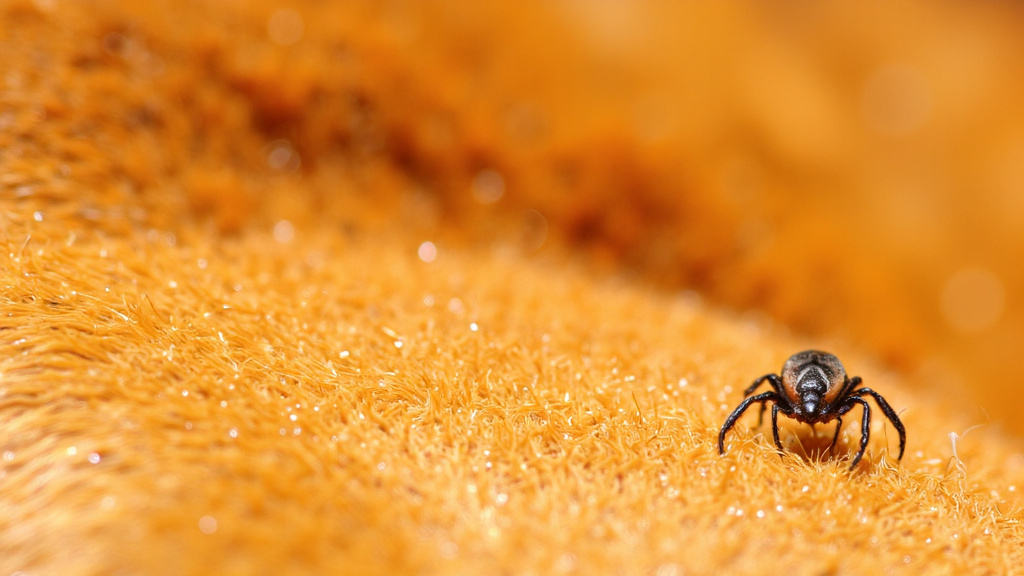
A sudden bump discovered on your dog can be concerning. While some bumps are harmless skin tags, ticks have distinct characteristics that dog owners should be able to identify.
Ticks appear as small brown or grey-ish bumps attached to the skin. Unfed ticks are approximately 1/8 to 3/16 inch long—similar to a freckle or poppy seed. After feeding, they expand significantly, reaching the size of a small lima bean or grape when fully engorged with blood, making them more noticeable during grooming.
These parasites have eight legs that curve around their bodies, with two pairs angling toward the head and two pairs toward the abdomen. This spider-like leg arrangement distinguishes ticks from skin growths. Their small head relative to their abdomen creates a distinctive profile when viewed closely. The skin around an attached tick often becomes red and swollen as the body reacts to the parasite.
What Are the Most Common Types of Ticks Found on Dogs?

Several tick species across the United States pose significant health risks to dogs. Understanding each species’ characteristics, regional presence, and associated diseases is crucial for dog owners.
American Dog Tick (Dermacentor variabilis)
American Dog ticks have a brown body with distinctive white marbling on their dorsal shields. Adult females measure about 5mm unfed and can expand to 15mm when engorged.
These ticks are prevalent in the eastern United States, Midwest, and parts of the Northwest. They inhabit grassy areas with low vegetation where they can easily attach to passing hosts.
American Dog ticks transmit Rocky Mountain Spotted Fever and tularemia, with peak activity during spring and summer months.
Brown Dog Tick (Rhipicephalus sanguineus)
Brown Dog ticks have a uniformly reddish-brown color without distinctive markings. Their narrow, elongated body shape and reddish-brown legs make them easily identifiable.
These ticks can complete their entire lifecycle indoors, thriving in kennels, homes, and dog shelters throughout the United States, presenting a year-round threat.
They transmit canine ehrlichiosis and babesiosis. A single female can lay up to 4,000 eggs, potentially causing severe home infestations.
| Tick Species | Identifying Features | Region | Diseases Transmitted |
|---|---|---|---|
| American Dog Tick | Brown body with white marbling on dorsal shields | Eastern US, Midwest, Northwest | Rocky Mountain Spotted Fever, Tularemia |
| Brown Dog Tick | Uniform reddish-brown, narrow elongated body | Throughout US, more common in southern states | Canine ehrlichiosis, Babesiosis |
| Blacklegged (Deer) Tick | Reddish-orange body, black legs, black dorsal shield | Northeastern, Upper Midwest US | Lyme Disease, Anaplasmosis, Babesiosis |
| Lone Star Tick | Reddish-brown with white spot on females | Southeastern, Eastern US, Midwest | Ehrlichiosis, Tularemia, Alpha-gal Syndrome |
| Western Black-legged Tick | Dark legs, reddish-brown body | Pacific Coast, particularly California, Oregon, Washington | Lyme Disease, Anaplasmosis |
| Rocky Mountain Wood Tick | Brown bodies with cream-colored patterns | Rocky Mountain states, Southwestern Canada | Rocky Mountain Spotted Fever, Tularemia, Colorado Tick Fever |
Blacklegged (Deer) Tick (Ixodes scapularis)
Blacklegged ticks have a reddish-orange body with black legs and dorsal shield. Adults measure about 3mm when unfed, notably smaller than American Dog ticks.
These ticks are common in northeastern and upper midwestern United States, particularly in wooded areas with thick underbrush. They’re most active during fall and early spring.
As primary Lyme disease vectors, they also transmit anaplasmosis and babesiosis. CDC research shows up to 50% of adult Blacklegged ticks in some northeastern regions carry the Lyme disease bacterium.
Lone Star Tick (Amblyomma americanum)
Female Lone Star ticks display a distinctive white spot on their reddish-brown bodies, while males have white markings around their outer edge.
These aggressive feeders inhabit the southeastern and eastern United States, extending into the Midwest. They prefer humid woodland environments with dense underbrush.
They transmit ehrlichiosis, tularemia, STARI, and can cause alpha-gal syndrome, potentially leading to meat allergies in hosts.
Western Black-legged Tick (Ixodes pacificus)
Western Black-legged ticks feature dark legs against a reddish-brown body, similar to their eastern counterparts but with a more limited range.
They primarily inhabit the Pacific coast, especially California, Oregon, and Washington, preferring coastal scrub and mixed hardwood forests with high humidity.
These ticks transmit Lyme disease and anaplasmosis, with populations expanding northward into British Columbia as temperatures warm.
Rocky Mountain Wood Tick (Dermacentor andersoni)
Rocky Mountain Wood ticks display brown bodies with cream-colored patterns on their dorsal shields, resembling American Dog ticks but inhabiting different regions.
Found in Rocky Mountain states and southwestern Canada, they prefer sagebrush and medium-height grasses at 4,000-10,500 feet elevation.
They transmit Rocky Mountain spotted fever, tularemia, and Colorado tick fever. Their females can produce a neurotoxin causing tick paralysis in dogs when attached near the spine.
How Do Ticks Change Appearance When Attached to Dogs?
When ticks first attach to dogs, they appear as tiny, flat, dark brown or reddish-brown parasites, about the size of a poppy seed or small freckle. Their small size makes them difficult to spot, especially in dogs with darker or thicker coats.
During feeding, ticks transform significantly. The tick inserts its specialized mouthparts—equipped with tiny, saw-like structures—into the dog’s skin to consume blood. As this occurs, the tick’s body expands and its color shifts from dark brown to a lighter gray or slate-gray.
The Feeding Process and Physical Changes
Female ticks display the most dramatic changes during feeding. Within 24 hours, they begin swelling noticeably. By day three or four, their bodies become significantly distended, taking on a rounded, raisin-like appearance. After 5-7 days, fully engorged female ticks can double their original size, reaching up to 1/2 inch (10-12mm) in length.
Male ticks remain relatively small and flat throughout feeding, making females more noticeable when both are present. Males typically attach primarily for mating rather than extended feeding.
| Stage | Size | Color | Shape | Texture |
|---|---|---|---|---|
| Before Feeding | 1/8 to 3/16 inch | Brown or reddish-brown | Flat and oval | Not specified |
| After Feeding | Up to three times original size | Darker, often grayish or blackish | Rounded and distended | Shiny due to blood inside |
| Fully Engorged | Up to 1/2 inch | Slate gray or deeper reddish-brown | Oval, rounded, or balloon-like | Not specified |
Species-Specific Changes
Different tick species show unique characteristics during engorgement. American dog tick females become slate gray when fully fed, while lone star ticks develop a uniform brown appearance despite their distinctive white markings when unfed. Brown dog ticks, common in homes and kennels, turn a deeper reddish-brown when engorged.
This transformation makes species identification challenging after several days of feeding. Distinctive markings that help identify unfed ticks become obscured as the body expands with blood.
Why Understanding These Changes Matters
Recognizing tick appearance changes enables early detection. Prompt removal reduces the risk of disease transmission, as most tick-borne pathogens require several hours of attachment before transmission occurs.
When examining your dog, recently attached ticks feel like small bumps against the skin, while fully engorged ticks resemble small beans or grapes. Focus on common attachment areas—between toes, inside ears, under collars, and in warm body folds.
Where Should You Look for Ticks on Your Dog?
Ticks strategically seek areas on your dog where the skin is thin and blood vessels are close to the surface. Knowing these key locations ensures thorough tick checks and early detection.
Dogs typically encounter ticks during morning walks, forest hikes, or backyard playtime. These parasites can remain undetected for hours while feeding, making regular checks essential.
Ears and Head Area
The ears provide ticks with a warm, protected environment. Check both the outside and inside of your dog’s ears, particularly the ear flaps and ear canal. The thin skin here, rich with blood vessels, attracts ticks.
Examine the entire head region – around the eyes, under the chin, and along the muzzle. Ticks often attach near eyelids where dogs can’t easily scratch.
Neck Region
The area under your dog’s collar requires careful attention. Remove the collar during each check to inspect thoroughly. Despite having thinner fur, ticks can easily hide here without direct physical examination.
Between Toes and Paws
The soft skin between toes provides perfect attachment points for ticks. Gently spread each toe to examine the spaces between them. Check under nails and on paw pads – common collection points during outdoor activities.
While many dogs resist paw handling, gentle persistence is crucial. The brief discomfort of examination outweighs the risks of embedded ticks.
Belly and Groin
The stomach area’s minimal fur barrier and abundant blood supply attract ticks. Roll your dog onto their back and search the entire underside, from chest to groin.
This area demands thorough attention as ticks here often go unnoticed during quick checks.
Under the Tail
The base of the tail and surrounding areas offer ticks an ideal hiding spot. Lift the tail and check the entire perimeter, including the anal area where skin is sensitive and accessible.
| Body Part | Inspection Tips |
| Ears and Head | Check both outside and inside of ears, including ear flaps and canal; inspect around eyes, under chin, and along muzzle. |
| Neck Region | Remove collar to inspect thoroughly; check for ticks hiding under the collar. |
| Between Toes and Paws | Gently spread each toe to examine spaces between them; check under nails and on paw pads. |
| Belly and Groin | Roll dog onto back and search entire underside from chest to groin. |
| Under the Tail | Lift tail and check entire perimeter, including the anal area. |
Checking Dogs with Thick Coats
Dogs with heavy fur require more thorough examination. Part the fur and examine the skin directly using a fine-toothed comb, working through one small area at a time.
Consider trimming fur during peak tick seasons. While shorter fur doesn’t prevent tick attachment, it significantly improves detection.
When to Check
Conduct tick checks after every outdoor activity, especially following walks in high-risk environments like wooded trails, tall grass, or brush-heavy parks. Since ticks begin feeding shortly after attachment, prompt inspection reduces disease transmission risk.
During peak seasons, perform daily full-body checks regardless of location. Remember that ticks can transfer from your clothes to your dog even outside typical tick territories.
Protecting Your Dog from Ticks: Essential Safety Measures
Protecting your dog from ticks requires year-round vigilance to prevent potentially serious diseases. With proper strategies, you can minimize tick-borne illness risks while maintaining an active outdoor lifestyle with your dog.
Vigilant tick prevention combines regular checks, vet-approved treatments, and smart outdoor management. Tools like the Halo Collar add a valuable layer of protection by using GPS tracking and customizable wireless fences to keep your dog within safer, tick-reduced areas—away from overgrown brush or wooded terrain where ticks thrive.
By pairing consistent tick checks with smart boundaries, you can confidently support your dog’s health while they enjoy the outdoors safely.
Interested in exploring more common canine health and safety concerns? Visit our dog health and dog safety pages for expert tips and advice on a wide range of issues





